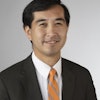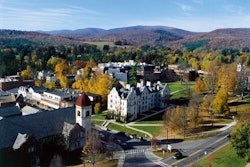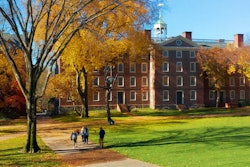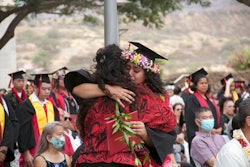The ‘Other’ Asians
With their numbers on the rise, Indian, Pakistani and other South Asian scholars are gradually emerging from academe’s shadows.
When Dr. Madhulika Khandelwal did a computer search for literature about Indian immigrants in 1986, she got back thousands of hits.
“I thought, ‘Wow! I thought there was nothing.’ But there were thousands of titles,” says Khandelwal, a professor of Asian American Studies at the University of Massachusetts-Boston.
A closer look at her results revealed that that the computer was pulling up references to Native Americans.
“In America, ‘Indian’ means American Indian,” Khandelwal says.
Confusion continues to reign about one of America’s fastest growing immigrant ethnic groups, most of who come from the Asian countries of India, Bangladesh, Pakistan and Sri Lanka. And as their numbers grow in the academy, scholars say stereotypes and ignorance about South Asian culture and religion abound.
“It does lead to confusion because people don’t know who we are,” Khandelwal says. “People say we’re not Asian Americans because we don’t look Asian. And they say, ‘Well who are you? You look so much like Arabs. Why aren’t you in the Middle Eastern category?'”
But scholars say that may be changing as Asian American studies programs offer more courses about South Asians and as a new generation of scholars enters the academy and pursues research about the group.
International students from India comprise the second largest ethnic group of non-citizens earning their Ph.D.s at U.S. colleges and universities. In 1997, Indian students earned 3.2 percent of the total number of doctorates, almost the exact percentage of doctoral degrees earned by African American students (see BI The Numbers, pg. 25). South Asians represent roughly 6.2 percent of the 70,501 foreign scholars working on U.S. campuses and nearly 7.5 percent of the 490,933 international students, according to the Institute of International Education. And then there are the hundreds of South Asian scholars and students who are American-born but whose numbers are difficult to discern because most institutions do not collect demographic data that distinguishes them from other Asian Americans.
Despite their growing numbers, South Asians have been loath to flex their political muscles or be vocal about religious intolerance or discrimination. But experts say that reticence soon may be ending in the academy.
Striving for Recognition
In December, Dr. Cynthia Mahabir, a former San Jose State University professor who accused the institution of denying her tenure because she is Indian, won more than $206,000 in an out-of-court settlement. Mahabir, a native of Trinidad and of Indo-Caribbean descent, alleged that her department chairman, Dr. Cobie Harris, told a faculty meeting in December 1994, that “African American Studies has no room for an Indian.”
“I expected to be granted tenure,” says Mahabir, who is now a lecturer at Laney College in Oakland, Calif. “I had three levels of review and they all recommended that I be granted tenure. I should be able to teach African American Studies,” she says. “This really jolted me. I was left with a hollow feeling.”
University officials say that Mahabir was denied tenure because she had published only three articles and a book review (see Black Issues, Jan. 6, 2000).
Attorneys say that in the academic community, South Asian scholars like Mahabir are beginning to file lawsuits rather than simply accept decisions they feel are discriminatory.
“I think that culturally, the culture is that you just don’t protest,” says Deepa Iyer, staff attorney with the National Asian Pacific American Legal Consortium in Washington, D.C. “The cultural tendency is to deal with [the problem] or hope it will change. But there is a shift in the way our community is beginning to respond…. They are now seeing more clearly the very visible differences in the way they may be treated compared to Whites and other people, and they are more prone to assert their rights.”
South Asian students are also starting to organize. Last month, 3,000 students attended the sixth annual South Asian Student Alliance meeting at the University of Texas a-Austin.
Scholars say part of the problem in academia is that South Asians are seen as a model minority group — hard-working and intelligent.
“But we’re not recognized for our hard work,” says Dr. Vijay Prashad, assistant professor of international studies at Trinity College who has challenged Dinesh D’Souza’s arguments about South Asian success in America.
It’s a topic Prashad explores in his new book, The Karma of Brown Folk, which looks at the complexities faced by South Asians as members of a “model minority” — a group that Prashad says is consistently deployed as a “weapon in the war against Black America.” He was inspired to write the book when he read The Souls of Black Folk, in which W.E.B. DuBois asks Black Americans, “How does it feel to be a problem?” When Prashad asks South Indians, “How does it feel to be the solution?” he says he is questioning the model-minority myth.
“There is a real social cost, because many young Indians feel intense pressure to live up to the image,” Prashad says.
And he asserts that the stereotypes ignore the evidence that there are many South Asians who are not successful and who are struggling in this country. Indians are often given jobs because they work hard, he says, but they don’t get the recognition — especially in the academy.
“In academia, there is a two-tier system [for South Asians] that is similar to the one at work for professors in African American studies. Just because [Gayatri Chakravorty] Spivak is an international celebrity doesn’t mean Indian scholars don’t have a difficult time,” Prashad says. “In African American studies, they say ‘There’s Cornel West. How come you aren’t like Cornel?’ Everybody wants to point to a few celebrities.”
Bucking the Stereotypes
In addition to the model minority baggage, South Asian scholars have to navigate around other problems brought on by the ignorance of those around them.
“Stereotypically [Asians] are presumed to have had limited access to English before arriving in America,” Khandelwal says. “They are considered followers rather than leaders. And the women are seen as either downtrodden or sexual ‘exotics.'” She recalls being praised once after a lecture because she “spoke so well.”
“I grew up speaking English,” she says. “People have forgotten that India was colonized by the British. In general, [American] information about other cultures is very little and most of it is stereotypical.”
The stereotype also lingers that South Asians are only adept in certain disciplines, like the sciences or technology and not as likely to succeed in fields like the social sciences and humanities. Khandelwal recounts the experiences of a South Asian English professor she knows who, despite having taught in India, had a difficult time finding even adjunct positions in the United States.
“The departments were incredulous,” she says. “How could she teach Shakespeare? And the students looked at her in astonishment like ‘what could she teach us about English?’ The moment someone sees what you look like, they’ve made up their mind about you. Your entire life is summed up. My friend said she knew what it felt like to be a person of color in the U.S.”
But others say they have not had a problem teaching in disciplines other than the sciences or Asian American studies.
“I’ve never been type-cast as a post-colonial scholar,” says Dr. Rajini Srikanth, professor of English at the University of Massachusetts-Boston. That’s why I enjoy teaching William Faulkner even though I’m a South Asian woman scholar.”
Historically, a number of South Asian professors have taught at historically black colleges anduniversities because it was difficult for them to get jobs at predominantly White universities. This is a boon to HBCUs who find themselves competing for the scarce number of African American scholars in the sciences, says Dr. Isaac J. Crumbly, director of Fort Valley State University’s Cooperative Developmental Energy Program.
When Dr. Aditya Kar accepted a job as a professor of geology at Fort Valley he had no idea where the university was located. “A lot of Indians tend to stay in cliques and they don’t really have any contact with African Americans,” he says. “Indians are very class- and color-conscious and when they move here they move to the right and White.”
But Kar says he could relate easily to Black people. “In India, I was a middle-class Hindu-born male. I didn’t have to think about minority issues.”
In America, however, he found that “overnight I turned into a minority. I talk with an accent, I have Brown skin and I have Black hair. Unless you’re a minority, you won’t understand.”
Kar says he finds himself at home on Black college campuses, because the culture is less formal than that of predominantly White universities. In many ways, he says, “Black culture is somewhat similar to Indian culture.”
An Emerging Area of Scholarship
Srikanth believes the future is bright because of a shift in the way Asian American studies sees South Indians. Until recently, “South Asians were not seen as authentic Asian Americans professors,” Srikanth says.
On college campuses around the country, professors say there is a burgeoning of courses about South Asians. Until the early 1990s, there were very few courses being taught. The new courses are partly a result of the scholarship being done by a younger generation of scholars “who are coming out and saying we want to write about this,” says Khandelwal, who teaches a class called “Becoming South Asian.”
“The term South Asian is being coined,” Khandelwal says. “South Asians are not monolithic and traditionally think of themselves as Indian, Bangladesh or Pakistani.” But now, scholars say South Asians are trying to forge a new identity as an ethnic group in the United States.
“These new courses are breaking ethnic boundaries and cutting back and forth across issues of race and culture,” Prashad says.
— Elizabeth Softky and Cheryl D. Fields
contributed to this story.
© Copyright 2005 by DiverseEducation.com





















